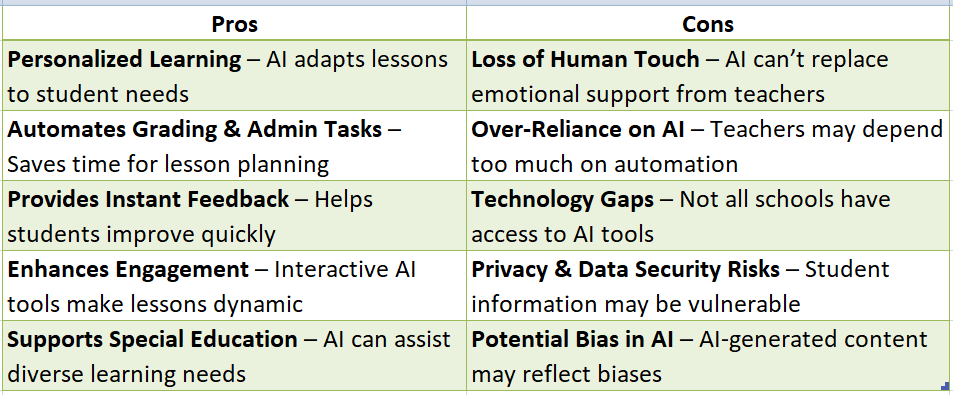
In today’s digital landscape, Teachers Using AI to enrich classroom learning experiences. By incorporating technology into their teaching, educators can create personalized environments that meet the diverse needs of students, engaging them and preparing them for a tech-driven future.
Personalized Learning
- Adaptive Learning Platforms: These tools tailor content to individual student performance, ensuring personalized progress.
- Data-Driven Insights: Teachers can analyze data to identify strengths and weaknesses, customizing instruction accordingly.
Enhancing Engagement
- Interactive Tools: AI applications make learning more engaging, allowing students to explore subjects creatively.
- Gamification: Game elements in lessons motivate students and foster a love for learning.
Supporting Teachers
- Automating Administrative Tasks: AI streamlines grading and scheduling, allowing teachers to focus on instruction.
- Professional Development: AI resources help teachers enhance their teaching strategies.
By embracing AI, educators are transforming classrooms and equipping students to thrive in a technology-rich world. Students can leverage AI for research, homework help, and collaborative projects, further enhancing their educational experience.
Unlock your potential with online degrees—Learn more!
How Teachers Using AI Personalize Learning Experiences
In today’s educational landscape, teachers using AI are transforming student learning. By incorporating artificial intelligence into their methods, educators can customize learning experiences to cater to individual needs, enhancing both effectiveness and engagement. This personalized approach not only improves understanding but also nurtures a passion for learning.
Personalized Learning Paths
AI allows teachers to develop tailored learning paths by analyzing performance data to identify strengths and weaknesses. This enables educators to:
- Adjust lesson plans
- Provide targeted resources
- Offer real-time feedback As a result, students can progress at their own pace, maximizing their potential.
Enhancing Engagement with Technology
Additionally, technology and children complement each other in the classroom. AI tools make learning interactive and enjoyable, motivating students to actively participate. For example, gamified learning platforms encourage engagement with the material, making education a more enjoyable experience. Thus, teachers are not just using AI; they are reshaping the educational experience for their students, equipping them for a tech-driven future.
Enhancing Student Engagement Through AI Tools
In today’s digital age, teachers are increasingly leveraging AI to enhance learning experiences. By integrating AI tools into the classroom, educators can foster greater student engagement and personalize learning paths. This approach not only supports diverse learning styles but also prepares students for a tech-driven future.
Personalized Learning Experiences
AI allows teachers to tailor lessons to individual student needs. By analyzing performance data, educators can identify areas where students struggle and adjust their teaching methods accordingly. This personalized approach ensures that every student receives the support they need to thrive.
Interactive Learning Environments
AI tools can create interactive and immersive learning experiences. For instance, virtual reality applications can transport students to historical events or scientific phenomena, making lessons more engaging. This technology and children combination sparks curiosity and encourages active participation in the learning process.
Can AI Help Teachers Identify Learning Gaps?
As education evolves, the integration of technology has become crucial. Teachers using AI are discovering innovative ways to enhance learning experiences. By leveraging artificial intelligence, educators can better understand their students’ needs, making it easier to identify learning gaps and tailor their teaching methods accordingly.
Personalized Learning Insights
AI tools analyze student performance data, providing insights into individual learning styles and challenges. This allows teachers to:
- Identify specific areas where students struggle.
- Customize lesson plans to address these gaps.
- Monitor progress over time, ensuring effective learning strategies are in place.
Streamlined Assessment Processes
With AI, teachers can streamline assessments, making it easier to pinpoint where students need additional support. This technology not only saves time but also enhances the overall educational experience for both teachers and students. By understanding how can students use AI in school, educators can foster a more engaging and effective learning environment.

The Impact of AI on Teacher Workloads: A Double-Edged Sword
As educators increasingly adopt technology, it’s vital to understand how teachers are using AI to enhance learning. AI tools streamline administrative tasks, enabling teachers to concentrate on student engagement, but they also introduce challenges that can significantly affect workloads.
Benefits of AI in Education
- Efficiency: AI automates grading and administrative duties, saving teachers time.
- Personalization: It allows for tailored learning experiences that cater to individual student needs.
- Resource Accessibility: AI provides instant access to a variety of educational resources, improving lesson planning.
Challenges Faced by Teachers
Despite these benefits, teachers encounter several hurdles:
- Learning Curve: Adapting to new technology can be daunting and time-consuming.
- Dependence on Technology: Relying too heavily on AI may undermine traditional teaching methods.
- Data Privacy Concerns: Protecting student data is increasingly important in today’s tech-driven environment.
Recognizing these factors is essential for educators to successfully integrate AI into their teaching strategies.
Innovative AI Applications in Special Education
In today’s educational landscape, teachers are increasingly leveraging AI to enhance learning experiences, particularly in special education. This innovative technology not only supports diverse learning needs but also empowers educators to create personalized learning environments. By integrating AI tools, teachers can better engage students and foster an inclusive atmosphere that promotes growth and understanding.
Personalized Learning Plans
- AI can analyze individual student data to tailor learning plans that suit their unique needs.
- This customization helps in addressing specific challenges faced by students with disabilities, ensuring they receive the support they require.
Real-Time Feedback
- Teachers using AI can provide immediate feedback on assignments, allowing students to learn from their mistakes promptly.
- This instant response helps students stay motivated and engaged in their learning journey.
Enhanced Communication
- AI tools can facilitate communication between teachers and students, especially for those with speech or language difficulties.
- Technologies like speech recognition and text-to-speech can bridge gaps, making learning more accessible for all students.
What Are the Ethical Considerations for Teachers Using AI?
As teachers increasingly adopt technology, the use of AI in education raises important ethical considerations. While AI enhances learning, educators must address issues like data privacy, bias, and student dependency. Understanding these factors is vital for responsible AI implementation.
Data Privacy Concerns
- Student Data Protection: Teachers must ensure the confidentiality and security of student data.
- Informed Consent: It’s crucial to inform students and parents about data usage and obtain necessary consent.
Addressing Bias in AI
- Algorithmic Fairness: Educators should be aware of potential biases in AI systems and select tools that promote equity.
- Diverse Learning Needs: AI should accommodate various learning styles to benefit all students equally.
Dependency on Technology
- Balancing AI Use: Teachers should foster critical thinking and problem-solving skills, avoiding over-reliance on AI.
- Promoting Digital Literacy: Educators must guide students in using AI responsibly, preparing them for a tech-driven future.
Unlock your potential with online degrees—Learn more!
Real-World Success Stories: Teachers Using AI Effectively
In today’s digital age, teachers are leveraging AI to enhance learning experiences by creating personalized paths tailored to individual student needs. This integration fosters engagement and aids in understanding complex concepts more effectively.
Personalized Learning Experiences
AI tools, such as DreamBox and IXL, allow teachers to customize lessons according to each student’s learning pace, ensuring that no one is left behind in a technology-driven world.
AI-Driven Assessment Tools
AI is transforming assessments with tools like Gradescope, which enable efficient grading and provide instant feedback. This immediate response helps students learn from their mistakes, making assessments more constructive.
Additionally, AI helps teachers identify students needing extra support by analyzing data trends. This proactive approach allows educators to intervene early, ensuring every student has the opportunity to succeed. Overall, AI integration in education is reshaping how teachers engage with students, making learning more effective and enjoyable.
How CollegeAndTuition.com Supports Teachers in Integrating AI
In today’s digital landscape, teachers are harnessing AI to enrich learning experiences. By integrating AI tools, educators can personalize instruction, streamline administrative tasks, and provide real-time feedback, creating a more engaging classroom environment essential for preparing students for a technology-driven future.
Personalized Learning Experiences
- Adaptive Learning Platforms: These tools tailor content to individual student performance, ensuring personalized progress.
- Data-Driven Insights: Teachers gain access to analytics that reveal student strengths and weaknesses for targeted support.
Streamlining Administrative Tasks
- Automated Grading: AI aids in grading, allowing teachers to dedicate more time to instruction.
- Efficient Communication: AI chatbots manage routine inquiries, improving communication efficiency.
Enhancing Student Engagement
- Interactive Learning Tools: AI applications promote exploration of subjects, making learning interactive.
- Gamification: Game-like elements in lessons boost motivation and engagement, making education enjoyable.
By adopting these AI technologies, educators enhance their teaching methods and empower students to effectively use AI, improving academic performance and fostering critical thinking skills for future challenges.
Future Trends: The Evolving Landscape of AI in Education
As we look to the future, the role of AI in education is becoming increasingly vital. Teachers using AI are not just enhancing traditional learning methods; they are transforming the educational landscape. By integrating AI tools, educators can personalize learning experiences, making them more engaging and effective for students.
Personalized Learning Experiences
AI enables teachers to tailor lessons to individual student needs. This customization helps address diverse learning styles and paces, ensuring that every child receives the support they need to thrive.
Enhanced Administrative Efficiency
AI can automate administrative tasks, allowing teachers to focus more on instruction. By streamlining grading and attendance, educators can dedicate more time to engaging with students and fostering a positive learning environment.
How Can Students Use AI in School
Students can leverage AI for research, homework assistance, and even language learning. Tools like chatbots and educational apps empower them to explore subjects at their own pace, making learning more interactive and enjoyable.
Unlock your potential with online degrees—Learn more!
FAQs
-
How can teachers use AI in the classroom?
Teachers can use AI for personalized learning, grading automation, lesson planning, student engagement, and identifying learning gaps. -
What are the benefits of AI for teachers?
AI can save time on administrative tasks, provide data-driven insights, support differentiated instruction, and enhance student learning experiences. -
Can AI replace teachers in the classroom?
No, AI is designed to assist teachers, not replace them. It can automate tasks and personalize learning, but human interaction and guidance remain essential. -
What are some AI tools that teachers can use?
Popular AI tools include ChatGPT for content creation, Grammarly for writing assistance, Quizizz for AI-powered quizzes, and Khan Academy’s AI tutor for personalized learning. -
Is AI difficult for teachers to learn and use?
Many AI tools are designed to be user-friendly, requiring little to no coding knowledge. Teachers can start with simple tools like AI chatbots and adaptive learning platforms.





